I’d enrolled my young sons in a state-mandated two-day firearms hunter safety course and it was finally time for Day One. The long line outside the local fish & game clubhouse gun club eventually began to move, and as we stepped through the large front door, we were greeted by a dozen guns.
A Not-so Safe Gun Safety Course
Each firearm was neatly laid out on a conference table – with its muzzle pointed directly at us! Both of my sons picked up on this immediately. So much for Rule #2 (see below) and the credibility of the instructors. I don’t think they ever knew the difference, but I’m guessing we weren’t the only attendees who noticed this glaring contradiction. Only a short time later, firearms safety rules were conveyed with great solemnity.
Not that I’m knocking the value of the Firearms Hunter Safety Course. They’ve been around for years and their success in reducing hunting mishaps is beyond debate. In fact, thanks to the direct efforts of committed volunteer instructors, hunting is now among the safest sports.
Fortunately, the above example of a basic firearms safety tenet violation is an exception, but it does go to show that even some supposedly “experienced gun people” can be sloppy gun handlers. Too bad, because like some other fields, they’re also role models.
Would you want your kids in a vehicle with a Driver’s Ed instructor who runs stop signs or ignores yellow lines? Nope, me either. Worse would be lack of any training whatsoever. That’s why we don’t toss a set of keys to new drivers after having them read an owner’s manual.
All drivers make mistakes at one time or another, however. Just like with guns, sometimes those mistakes might just wake you up. Other times they might just end your life – or someone else’s. Safety is everything. Let’s start with the basics.
Four Universal Firearms Safety Rules
A simple but widely recognized set of safety rules has evolved. Initially developed by prominent trainers, today’s four “universal firearms safety rules” are now the gold standard for safe range operations and gun handling.
#1 – Always treat every firearm as if loaded.
#2 – Never let the muzzle cover anything you’re unwilling to destroy.
#3 – Always keep your finger off the trigger until the sights are on the target.
#4 – Always be sure of your target and what is beyond it.
Paradoxically, some gun buyers with little-to no experience take possession of new handguns, boxed with factory literature and a trigger locks. At that point, adios and out the door. With luck, the included paperwork will actually be read prior to handling. Most factory manuals do include safety rules, along with loading and unloading instructions. If followed to the letter, safe handling and operation should be possible at a basic level. However, safety information can vary, sometimes to address proprietary features.
Our Additional Firearms Safety Rules
Until recently, I was the Officer in Charge (OIC) of a busy government firearms training unit. During a nearly three-decade period involving thousands of shooters – thanks largely to the vigilance of well-qualified firearms training unit (FTU) cadre – we were able to maintain a spotless safety record. Beyond strict adherence to the above four rules we added several others, including:
#5: Check any firearm you handle upon assuming custody of it.
#6: If you don’t understand how it works, leave it alone.
#7: Don’t exchange a firearm unless the action is open.
These are firearm “rules of the road,” analogous to staying within yellow lines and obeying stop signs or red lights. Anyone with a safe driving record should be able to follow them. For other “accident-prone types,” pepper spray is a safer bet (the nozzle thingy points away from your face).
That said, many good drivers have been involved in some type of accident which could even be their fault. Likewise, many serious gun people have experienced one game-changing accidental discharge (AD). Such an event is often referred to as a “negligent discharge” (a technically more accurate assessment).
Either way though, it’s a serious wake-up call almost certainly related to Rule #3, and likely involving Rule #1 (for now, note the “almost certainly” caveat). In most cases these folks are still active if humbled shooters because Rules #2 and #4 were followed, confining collateral damage to underwear.
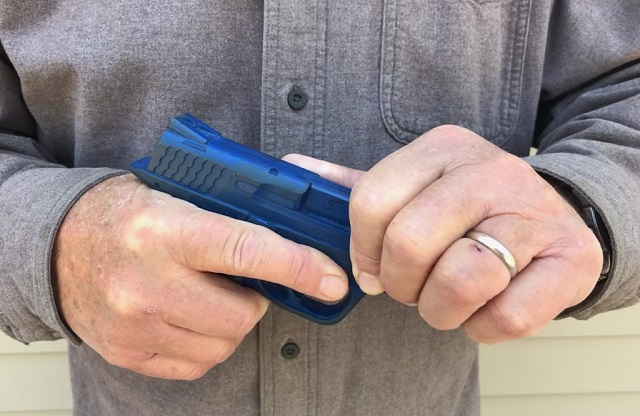
Still, some “experienced shooters” persist with sloppy gun handling. Watch the various gun-related shows on the outdoor channels and you’ll see supposed professionals violate Rule #2.
One regular occurrence involves muzzle-swept fingers during coverage of new handgun models. I’d love to hear a loud buzzer sound off every time this happened. Entertainment aside, the educational value for all would be priceless. Pay attention to others handling firearms in your proximity and you may note similar alarms. In fact, the aggravating mental buzzer could even involve you!
Muzzle control is a major concern, particularly among newer shooters. It’s just a whole lot easier to wave a handgun around, not that you can’t get in trouble with a shotgun or rifle. Heck, a guy in my military outfit succeeded in blowing a large hole through his hand with an M-60 machine gun. I could go on with plenty more stories, but I’d rather help avoid future ones.
Common Handgun Safety Violations
Plenty of additional basic safety information is available online, so instead of listing a bunch of dos and don’ts, I’ll note some potential areas of hazard we’ve witnessed with frequency, many while on ranges.
Removing a Firearm from a Case Muzzle Control
Think about where the muzzle will be pointing in relationship to others before opening a container, or removing a gun! Failure to do so is an all-too common screw-up, even though it’s among the easiest to address. We have the luxury of our own range, so we can manage this situation. Any handgun not holstered will be immediately cleared in a designated area and benched, action open, facing a safe backstop. This SOP is also employed during many combat-type pistol matches like IPSC. Sadly, such controls are necessary for a reason. Again, think about others in your proximity! And, FYI, most bullets will penetrate most walls.
Donning/Dismounting a Holster Containing a Handgun
There’s a good chance Rule #2 will be compromised through this practice. The safest bet is to skip it entirely. Remove the handgun first.
Two-Handed Recovery (Re-holstering)
This bad habit can develop through poor holster designs or clothing choices. If the support hand (the left one for most of us) goes to the holster ahead of the gun, sooner or later, it WILL be swept by the muzzle.
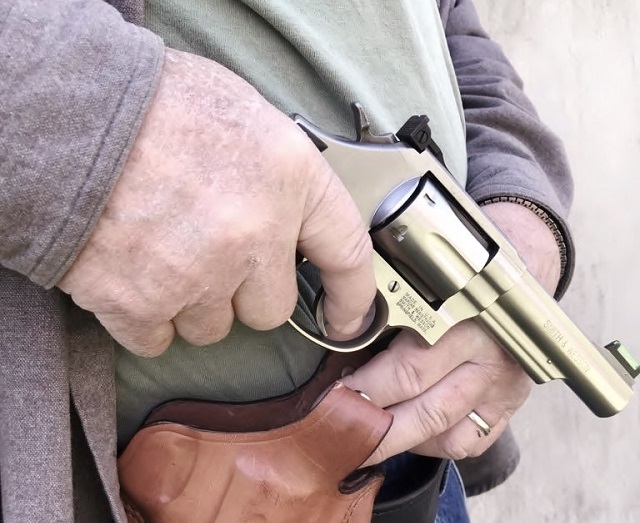
Trigger Finger Inside Trigger Guard During Recovery
Yup, you can shoot yourself with this Rule #3 violation. Simple fix; extend that digit to follow the holster’s exterior. Problem solved right? Maybe not…
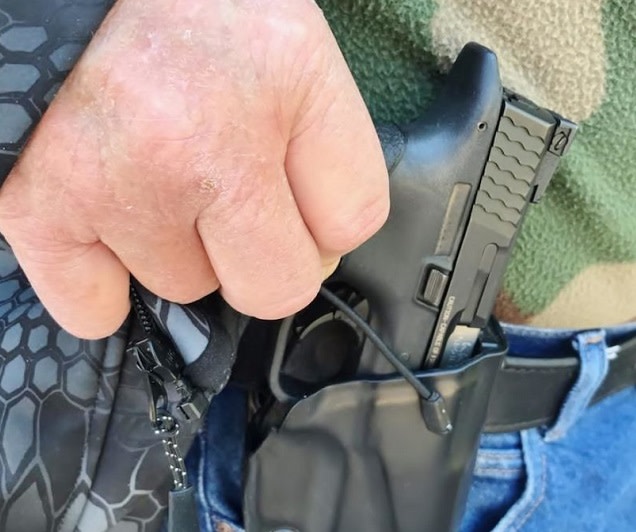
Foreign-Object Interference
Back to the “almost certainly” caveat, a piece of sweater or a drawstring that enters the trigger guard can cause a discharge while re-holstering – especially with striker-fired pistols that have so-called “trigger-safety” features. Errant items in pockets or purses can raise further havoc if they migrate into trigger guards.
Failure to Maintain Two-Handed Control
A conversation on a firing line can result in distractions that lead to a Rule #2 violation. Whether you talk with your hands or not, remove the support hand only during the recovery (re-holstering) process. Any conversations can wait until it’s completed.
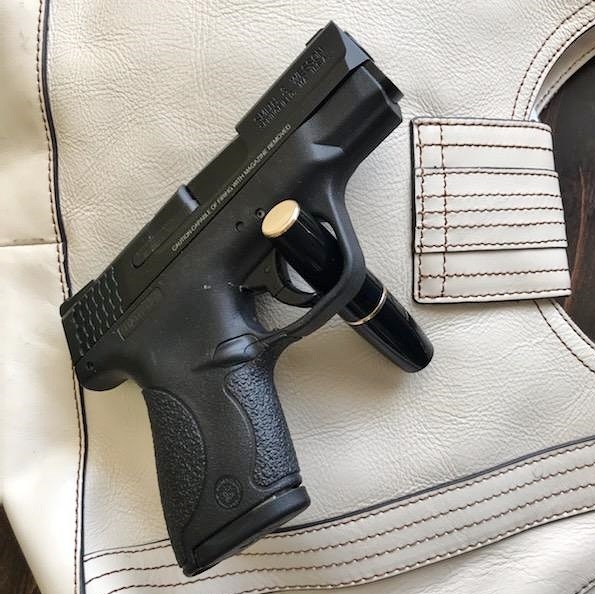
Failure to De-cock During Recovery
This omission can be stress-induced. It applies mainly to double-action pistols like a Beretta M-92, etc., however, single-action designs can pose similar risks (like 1911s holstered without thumb safeties engaged). The cure is as simple. Stop and think before recovering the gun.
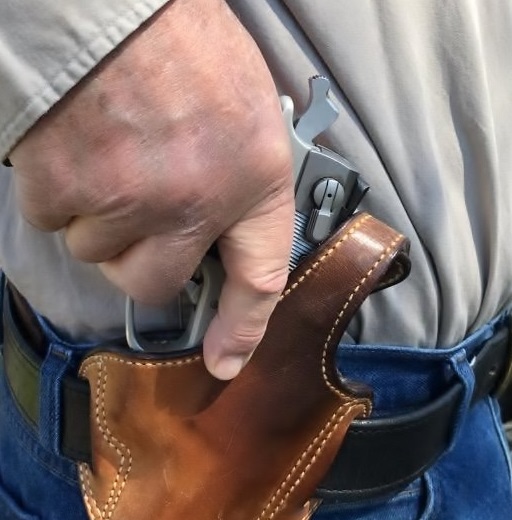
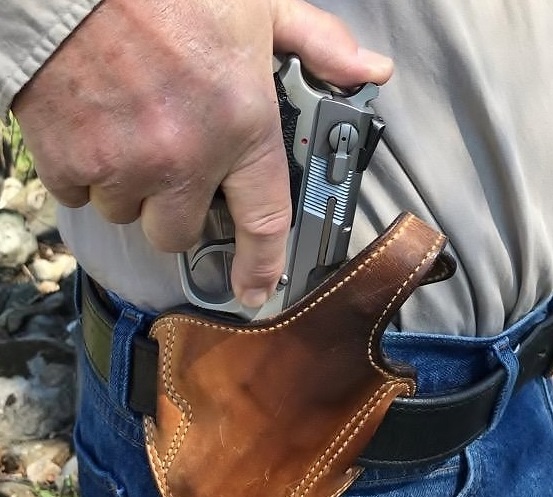
Breakdown of Trigger-finger Discipline
Although seen most often among new shooters, Rule #3 violations can surface as a result of marginal training – especially if the stress-meter begins to climb.
Malfunction-induced Brain Cramps
Muzzle discipline can evaporate, commensurate with the complexity of a stoppage. Stop and engage brain. Priority-one is Rule #2!
Unsafe Clearance
First, seek a safe location! Second, assuming the gun is a pistol, remove the magazine (preferably while still holstered). The chambered round is extracted last. Sounds simple enough, but this sequence is sometimes reversed. Look in the chamber(s) after unloading it. Look in that mag-well, too. Both should be empty! Swing-out cylinder revolvers are simpler but, regardless of the gun, check it at least twice!
Sloppy Gun Handling During Cleaning
Whether alone or in a group setting ALL of the rules apply! For whatever reason group cleaning-fests are especially prone to muzzle-related brain-farts.
A holster is worthwhile if allowed on your range. It’ll free up both hands and greatly improve muzzle control. Some facilities, especially indoor ranges, will restrict handgun usage to shooting bays, sans holsters. Whatever the circumstances, don’t handle firearms while others are downrange and factor in muzzle orientation.
Common Long-gun Safety Violations
Much of the above applies here as well. In my area, a former police chief received a refresher on “foreign object interference” by blowing off a thumb. His cruiser’s shotgun was stowed horizontally via S-hooks attached to a security cage. One hook passed through the trigger guard; never the best of plans. Neither was pulling the gun towards him, muzzle-first. When it comes to blowing off body parts though, there are worse alternatives, especially considering this “accident” happened in the busiest part of town. Which leads to…
Horizontal Guns
Commonly associated with vehicles, boats, or ATVs, odds of violating Rule #2 are high. Sometimes though, it’s the most expedient method. If so, an unloaded and cased gun offers some reassurance. Regarding passengers and multiple guns, just step aside during handling and take turns to avoid muzzle mayhem.
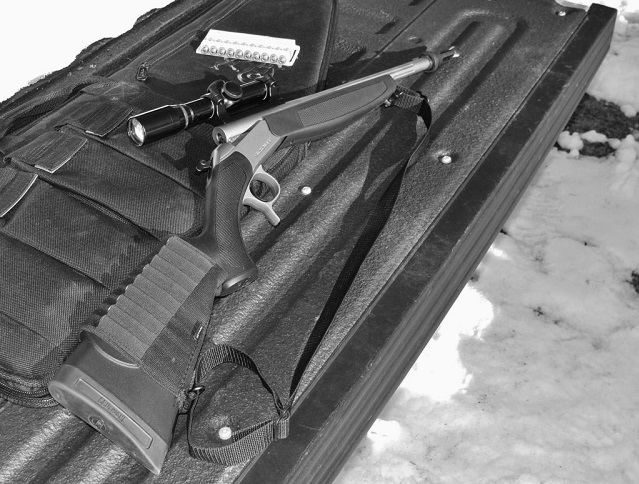
Carrying a Gun like a Hoe or Rake
A firearm deserves more respect – especially in the company of others. Extremely problematic were early carry-handle M-16s, which were routinely carried like luggage.
Unsafe Sling Carries and Dismounts
Single-point slings can be iffy regarding Rule #2 (see problems with single-point slings on AR-15s). Sporting-type slings are pretty basic, but an under-the-shoulder dismount can jeopardize anyone to the rear. Bending or stooping can create similar risks.
Leaning Guns
Running late, Billy notices Clem’s orange hat is still on the dash. So, Clem leans his deer rifle against the truck and hops back in – whereupon it tips over. What happens next is a matter of chance. Slippery butt-plates and floors don’t play well either. Some firearms can fire from a hard jolt, regardless of the safety being “on” (see below).
Steve is also the author of Shotguns: A Comprehensive Guide
Tree Stands and the Like
Per above, times ten! Climbing or descending with a loaded gun is suicidal, as are other gymnastics (like jumping creeks). Some people climb using a sling, but a separate hoisting system is better. Do a dry-run first though to check the angle of the dangle. You may be surprised!

Failure to Double-check a “Cleared” Gun
Don’t mindlessly cycle an action. If need be, use a light (vehicle headlights work) to visually ascertain clearance. With some types like shotguns, you can even insert a finger. I check everything before it enters a case, the house, or the safe. Anything coming out of the safe also gets checked.
Be More Mindful – Pause and Re-engage the Brain
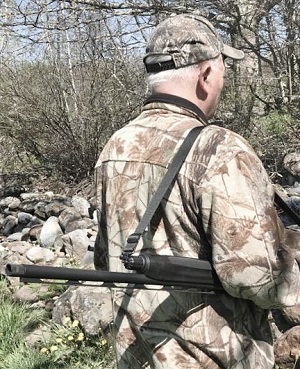
All of these hazards can be eliminated through a mental pause, just a quick time-out to think things over. The concept is similar to parking your shiny new vehicle on a steep incline. Thinking worst-case, you take a few extra seconds to cut the wheels inboard and apply the emergency brake.
Proper hands-on training is still essential. Normally, the affordable starting point is a local gun shop or club, affiliated with NRA Firearm Instructors (which differ from hunter safety). In a pinch, some new gun owners may turn to military or LE folks for guidance. Generally, that’s better than winging it, although muzzle awareness could still be shaky.
Common Gun Safety Violations Summarized
Rules #5, #6, and #7 are ignored with alarming frequency, either through ignorance or carelessness. Thus, Uncle Bud strolls into the living room with his pet gun. He hands it to his nephew, action closed. Neither bother to check it. That’s how the TV winds up getting shot… or worse, Aunt Edna. If it’s Auntie, the media will probably report the gun as having “accidentally fired.”
The reality is, if we cocked a gun, laid it on a table fully loaded, and waited for it to go off, we’d probably die of old age first. So is there such a thing as “accidentally fired” or is it really “negligent handling”?
They fire because someone activated the trigger. Safe storage methods are a story for another day. Meanwhile, controlled access is a paramount concern. Gun safes are good, but there are other options like secure handgun containers.
Back to that Hunter Firearms Safety Course, vertical storage would’ve been better, assuming a decent gun rack was present. Since one wasn’t, the area behind the rear wall was just woods – a direction much less likely to endanger human life. Sometimes there is no perfect solution. Like driving, firearm safety boils down to common sense – and awareness.
